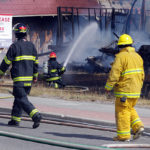Home »

A pattern of cut and run
Letter to the Editor
The popular question is: “What’s wrong with this picture?” Canfor’s announcement last week to permanently close the Canal Flats sawmill due to “a lack of economically available fibre supply” is a classic example of exploitation of our public forests and flies in the face the company’s policies regarding its commitment to communities and sustainability.
Here are direct quotes from Canfor’s 2014 Sustainability Report:
Communities
Canfor is a respected member of every community where we operate. At the end of the day, we want our neighbors to feel the community is stronger because Canfor is part of it.
Performance
Our actions demonstrate our commitment to sustainability in everything we do in every part of our operations everyday.
I bet the 80 laid-off workers and their families, along with the Village of Canal Flats, would have some strong opinions regarding these statements!
Do you know that Canfor has closed many Canadian mills in the past few years for the same reasons? Do you know that their 2014 annual report proudly crows about the recent purchase of six sawmills in the southern USA and their “rich and sustainable fibre supplies?”
Is this Canfor’s idea of commitment to Canadians? The pattern is beginning to look a lot like ‘cut and run!’
As a retired professional forester I am particularly concerned that this mill closure is another example of the failure of our present forest management system to protect the public interest, not just jobs, but the forest itself. Obviously, the remaining “economically viable fibre supply” is under considerable pressure with the consequence of negative impacts on our views, water, wildlife and recreational opportunities. If you have any doubts, get in your vehicle and drive the forest roads to see for yourself!
The company’s history has shown that it’s only a matter of time until another there is another mill closure – when the fibre runs out. Which workers will be next? Where is the government and professional forester oversight to ensure the public interest is protected? We can’t let the degradation of our forests and erosion of our jobs (to our competitors south of the border) continue. It’s time we look at the many viable alternatives to the relentless pursuit of multinational corporations for ultimate control of our public forests.
Jim Smith, RPF (ret)
Creston







